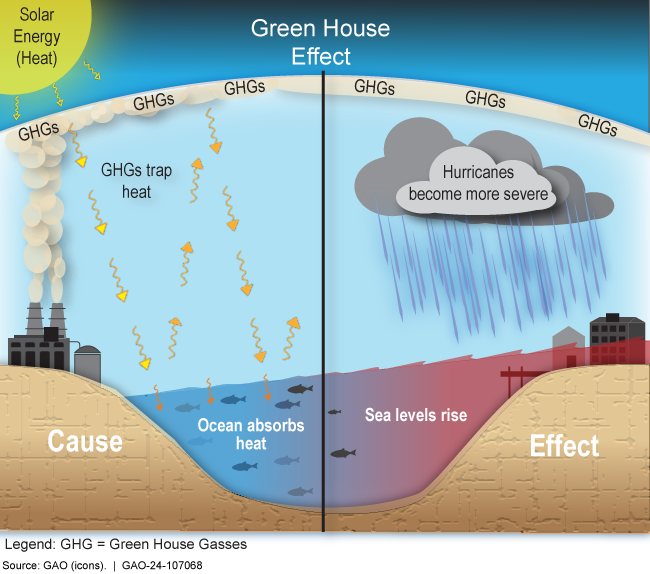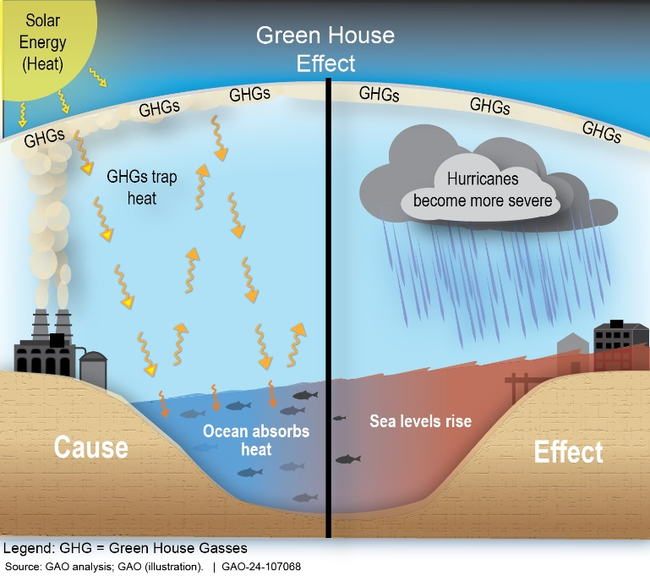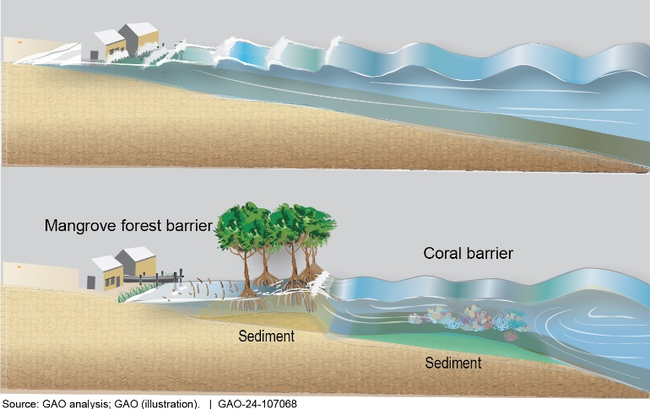Science & Tech Spotlight: Ocean Warming
Fast Facts
The ocean is storing much of Earth's excess heat. The resulting ocean warming contributes to problems such as rising sea level, ice-sheet melting, and coral bleaching.
This Spotlight report covers these and other issues, including effects on coastal communities and difficulty predicting change in complex systems like global ocean currents. We also discuss opportunities, like restoring mangroves as barriers against storm surges and other "nature-based solutions."
Policymakers could consider options such as research to improve data collection and simulation, or better intergovernmental coordination to address causes and effects of ocean warming.
Ocean Warming Process

Highlights
Why This Matters
The ocean is critical to human society and life on Earth. Its currents help shape the weather and regulate the climate. Its fisheries feed billions of people and accounted for 1.7 million jobs and $253 billion in sales in the U.S. in 2020. But the ocean is warming, which could lead to flooding, declining fisheries, more severe weather, and other negative consequences.
The Science
What is it? According to NASA, 2022 was the ocean's warmest year since modern record keeping began in 1955. Estimates indicate that the oceans account for more than 90 percent of the Earth's warming since at least 1971, mostly near the surface between 0 and 700 meters deep. To measure how much the oceans have warmed, researchers use various temperature sensing instruments in the water as well as satellites that measure sea level. Researchers then use these measurements to calculate the average heat gained in the oceans worldwide.
When sunlight reaches the Earth’s surface, the oceans absorb most of this energy and store it as heat. Water has a much higher heat capacity than air, so the oceans absorb larger amounts of heat energy with only a slight increase in temperature. The oceans’ ability to store heat is a crucial factor in moderating the pace of atmospheric warming. This heat is initially absorbed at the surface, but some of it eventually spreads to deeper waters. Increased heat absorption can change ocean currents that are driven by differences in temperature. Currents move heat around the world, influencing climate patterns and ecosystems.
What are some concerns? Ocean warming causes sea level rise through thermal expansion and by melting glaciers and ice sheets. Sea level rise can damage infrastructure and make coastal communities more vulnerable to storm surges and flooding. Global average sea level has risen 8-9 inches since 1880. In places such as Norfolk, Virginia; Miami Beach, Florida; and the San Francisco Bay Area, California, substantial investments are being made to cope with frequent coastal flooding that disrupts daily life and business operations.
Warmer ocean water also provides more energy for storms to develop and intensify. From 2000-2021, tropical cyclones in the U.S. caused $1 trillion in damages and 6,200 deaths. Ocean warming could result in even greater damage to property, infrastructure, and human health and safety.
Marine heatwaves—periods of abnormally warm ocean temperatures—can be caused by natural variability, but studies report that ocean warming is making them more frequent, intense, and prolonged. Marine heatwaves can stress and kill marine life and disrupt ecosystems. For example, they can cause coral bleaching, which can lead to the death of coral reefs and the ecosystems that depend on them.
As the ocean warms, some marine species move to cooler waters because they can only tolerate certain temperatures. Such changes can disrupt food chains and ecosystems. This can lead to a decline in fish populations and have cascading impacts on other marine life and the industries and communities that rely on them. For example, higher temperatures in the Bering Sea have been linked to a population collapse of snow crabs, with 10 billion crabs disappearing between 2018 and 2021.
Ocean warming can lead to more harmful algal blooms, which can produce toxins that can sicken people who eat seafood. These toxins can cause a range of health problems, including nausea, vomiting, diarrhea, and neurological problems.

Figure 1. Process of ocean warming
What are the knowledge gaps?
Global ocean heat inventory. Due to insufficient reliable measurements, there is limited knowledge about current and historical temperatures and warming across different oceans and depths. This leads to large uncertainties related to weather forecasts and prediction of extreme weather events, long-term impacts of ocean warming and adaptation capacity on ecosystems and species, and related management and governance issues.
Marine ecosystem impacts. The impact of ocean warming on marine ecosystems is not fully understood. This includes the effects of warming on marine biodiversity and food webs.
Ocean currents and circulation. The effects of ocean warming on ocean currents and circulation patterns are not well understood. Changes in these patterns could have significant impacts on global climate and weather patterns. Ocean currents play a critical role in regulating Earth's climate by transporting heat from one part of the world to another.
Challenges
- Understanding, predicting, and communicating complex systems. Scientists attempting to understand ocean warming are faced with complex systems with many interdependent parts, making it challenging to understand and predict how these systems will change over time. In addition, natural variability in the global climate, limitations of climate models, and measurement errors from imprecise instruments add to the complexity and limitations of predicting ocean warming. Communicating these complexities and uncertainties is also difficult.
- Tipping points. Some researchers predict that there are several potential tipping points, or thresholds, beyond which changes could become irreversible. Examples include the collapse of the Greenland ice sheet, the collapse of the West Antarctic ice sheet, tropical coral reef die-off, and permafrost thawing. Studies of Earth's history, using tree rings, ocean sediments, and ice cores, show tipping points occurring through large, rapid changes over the course of decades or as little as a few years. One such tipping point may have been reached about 12,000 years ago, abruptly ending a 1,000 year long, dry, cold period, and is associated with the extinction of over 70 percent of large mammals in North America. Understanding, predicting, and preventing these tipping points is complex.
- Effects on federal and military facilities and operations. Sea level rise and extreme weather events threaten some government property. These events, as well as changes to shipping routes due to changes in ice sheet formation, also affect military and rescue operations and could pose new security risks.
Opportunities
- Research. Scientists may be able to improve our understanding of these complex systems by improving monitoring and strengthening research to address knowledge gaps.
- Coordination. Governmental and nongovernmental entities could coordinate to better understand and adapt to ocean warming and to mitigate its effects.
- Nature-based solutions. Protecting and restoring marine and coastal ecosystems, such as planting kelp and seaweed forests, could help enhance the ocean's capacity to absorb greenhouse gases that contribute to atmospheric and ocean warming. Restoring mangroves and other coastal habitats can also sequester carbon and act as a barrier against storm surges and coastal erosion.

Figure 2. Nature-based solutions to adapt to ocean warming
Policy Context and Questions
- How can research initiatives improve data collection, modeling, and simulation related to ocean warming?
- What strategies could be employed to improve intergovernmental and international coordination to address the causes and effects of ocean warming?
- What policies, programs, or strategies could be used to help communities adapt to the effects of ocean warming?
For more information, contact Brian Bothwell at (202) 512-6888 or bothwellb@gao.gov.
